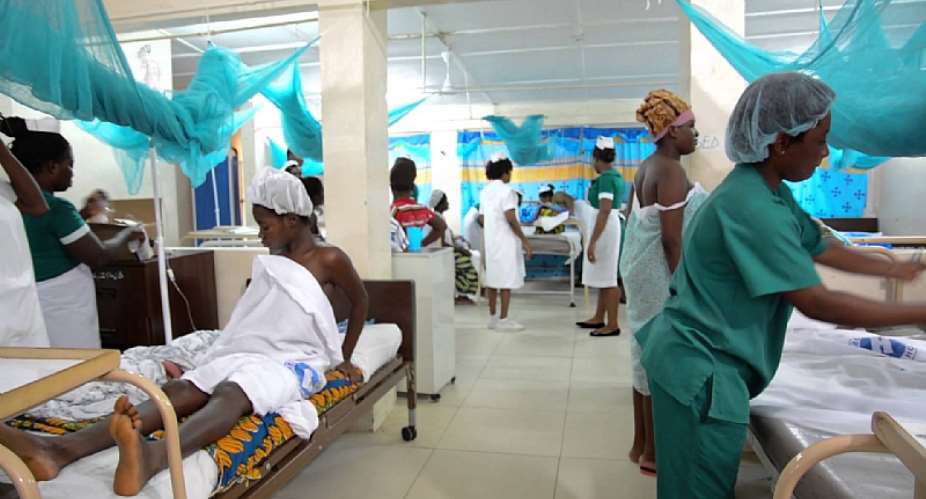The organizational structure of the Ghana Health System comprises many levels. These include the administrative levels which are further grouped into the national, regional and district levels; functional levels consisting of the national, regional, district, sub-district and community levels, and finally, the governance of the Ghana Health Service. After these demarcations, there are various offices held by different people under each of the levels which cut through. For example, in the hospital, there are senior medical officers, doctors, physician assistants, nurses, down to cleaners.
The cumbersome systems which are at work in the health sector of Ghana seem to be the enemy that militates against better health care delivery. In this article I would be considering what account for these. Many believe role perceptions would be the cause while others basically conclude that there might be less or no motivation and cooperation. Inasmuch as these laid-down structures and systems create a smooth atmosphere for functioning in the working environment, the behaviour of the workers are sometimes affected by these structures negatively. Have you been to the hospital, to meet the absence of the doctor who is supposed to administer health care to you before? Did you really like it when the nurses said they can’t do anything until the doctor comes? Did you think of what would happen between the doctor and nurses if the nurses had administered health care in his (the doctor’s) absence? Let us analyse the diagram below.
According to the organogram, imagine when a senior nurse has information to be delivered to the Director of health, how fast is that information going to get to him for it to be addressed? In the same way, when a feedback is supposed to come down to the senior nurse, how long is it going to take? In critical cases, the information end up being altered and thus, hinders decision-making process. In addition, different suggestions from different staff workers are gathered by a staff in the workplace which slows down the process of decision making since superiors try to consider all ideas to aid build a formidable diverse decision.
Considering the degree of respect accorded various workers, in relation to the position or office they hold on the organisational chart, superiors play down the views and suggestions put forth by their subordinates. This generates physical and verbal conflicts among workers. Despite the fact that all these workers might have acquired their basic knowledge from the same college with the same health background, those on top of the charts appear authoritative making them look down on their subordinates.

Disparities in the organisational structurecreate a room for improper healthcare delivery. Due to the lack of cooperation and coordination, the effect falls on the patient or the client. When nurses consider that they cannot administer health care in the absence of the doctors and physician assistants also cannot perform some actions without the doctors just because they think it is ethically wrong and not their responsibility in order to save themselves from any critics, they better don’t do it or delay and wait for the doctors.
To establish a serene working atmosphere, the structure must be broken down to a level where decision making can simply be made and also faster to aid smooth working and decision making. The beauraucratic system should be made short, simple and accessible. Nevertheless, superiors should employ open communication to aid proper and smooth decision making. This will make way for all the staff to contribute to decision making. In the long run, the heads would make decisions which gather concepts from all perspectives.
To end, the superiors should believe in their subordinates or train their subordinates to the level where they can trust their competency so that they can delegate power to them, by so doing health care delivery would go on smoothly and effectively, even in the absence of the people in charge.
This could be done for reliable ways to bridge the gap between proper and improper healthcare. This article is therefore opened to other suggestions.
ADUBOFOUR, WENDY
PHYSICIAN ASSISTANT STUDENT
LEVEL 200
UNIVERSITY OF CAPE COAST





 Lay KPMG audit report on SML-GRA contract before Parliament – Isaac Adongo tells...
Lay KPMG audit report on SML-GRA contract before Parliament – Isaac Adongo tells...
 Supervisor remanded for stabbing businessman with broken bottle and screwdriver
Supervisor remanded for stabbing businessman with broken bottle and screwdriver
 NDC watching EC and NPP closely on Returning Officer recruitment — Omane Boamah
NDC watching EC and NPP closely on Returning Officer recruitment — Omane Boamah
 Your decision to contest for president again is pathetic – Annoh-Dompreh blasts ...
Your decision to contest for president again is pathetic – Annoh-Dompreh blasts ...
 Election 2024: Security agencies ready to keep peace and secure the country — IG...
Election 2024: Security agencies ready to keep peace and secure the country — IG...
 People no longer place value in public basic schools; new uniforms, painting wil...
People no longer place value in public basic schools; new uniforms, painting wil...
 'Comedian' Paul Adom Otchere needs help – Sulemana Braimah
'Comedian' Paul Adom Otchere needs help – Sulemana Braimah
 Ejisu by-election: Only 33% of voters can be swayed by inducement — Global InfoA...
Ejisu by-election: Only 33% of voters can be swayed by inducement — Global InfoA...
 Minority will expose the beneficial owners of SML, recover funds paid to company...
Minority will expose the beneficial owners of SML, recover funds paid to company...
 Prof. Opoku-Agyemang has ‘decapitated’ the NPP’s strategies; don’t take them ser...
Prof. Opoku-Agyemang has ‘decapitated’ the NPP’s strategies; don’t take them ser...
